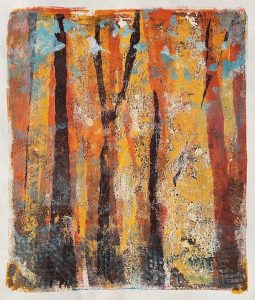
8×8 inches
Acrylic on black & white photocopy
©2016 Lucinda Howe
NFS
I started using a new tool this week, a Gelli Printing Plate. It’s a flexible surface for making monoprints and monotypes without a press using acrylic paints.
I’ve been watching instructional videos and experimenting with texture, stencils, stamps, and leaf prints. There’s a learning curve to discovering what paints work well and how much paint to apply to the plate. I’ve printed lots of plain copier paper that may (or may not) be useful later as collage elements.
This process makes me think in layers, in reverse when using letters, in terms of transparency or opacity of paints. The fun is in the uncertainty of outcome, the surprise when the print is pulled. I can see that Gelli printing may be additive. Even so, I won’t suddenly become a printmaker.
As with any other new tool or technique, I need some focused time for learning and practicing before I can claim it as my own. First efforts look like the instructor’s work, and aren’t satisfying. But as I use my favorite colors and shapes, the work will begin to look like mine. Eventually I will find ways to incorporate Gelli printing into my work along with other techniques. When that happens, I’ll know it has found a place in my toolbox.

Sharron Arnold
17 Jul 2016Lucinda, your gelliprinted ‘Nandina’ has inspired me to try that technique for the many Crotons I have in my garden. The negative painting really is very effective. I have also thoroughly enjoyed watching your large florals come alive. I tend to be very tight and precise and can see the benefit of painting LARGE!
lucindahowe
19 Jul 2016Thanks, Sharron. I’m having lots of fun with the florals and the Gelli plate. Both are unpredicatble enough to encourage looseness. Have fun printing your Crotons.